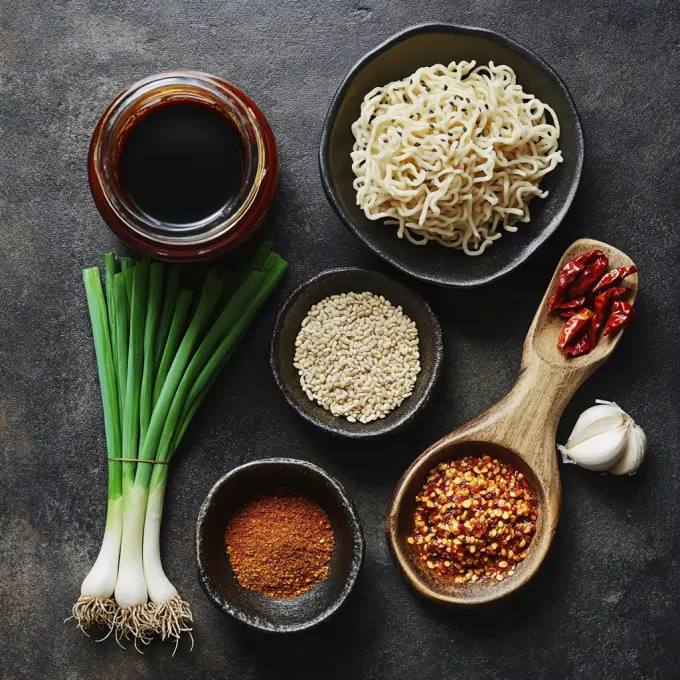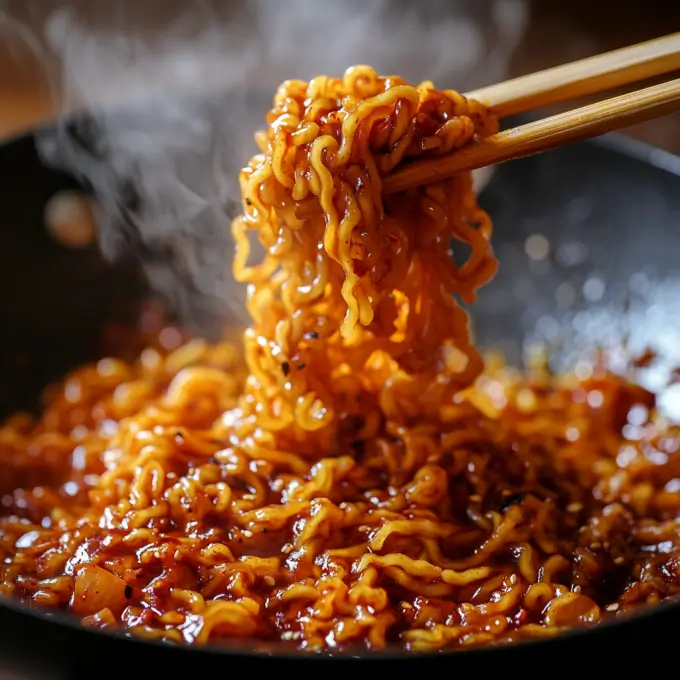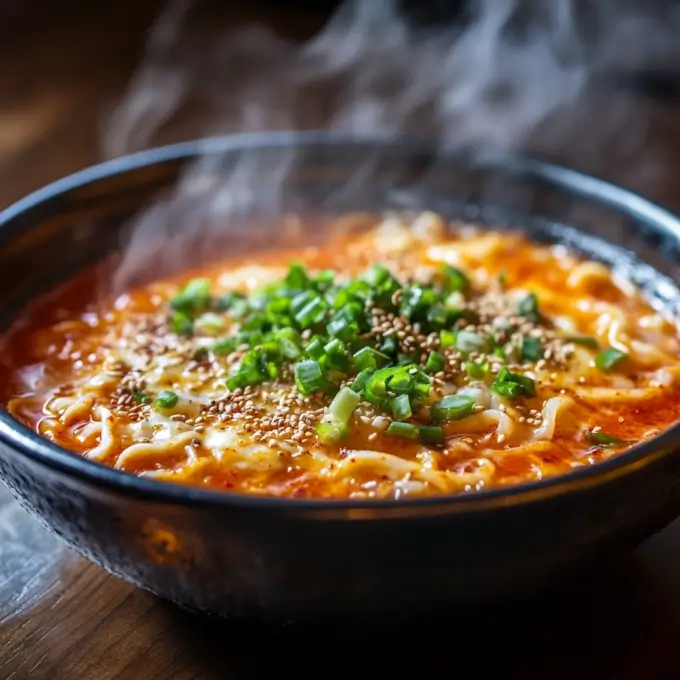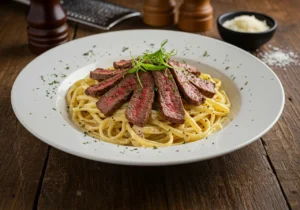If you’re craving an ultra-spicy and flavorful noodle dish, this buldak ramen recipe is the perfect choice. Known as Korean fire noodles, buldak ramen is famous for its intense heat and deliciously addictive taste. In this guide, you’ll learn how to make the best buldak ramen recipe at home, complete with tips to adjust the spice level and enhance the flavor.
By the end of this guide, you’ll be able to create a restaurant-quality Buldak Ramen right at home. Ready to dive in? Let’s get started!
Introduction to Buldak Ramen Recipe
What is Buldak Ramen?
Buldak Ramen (불닭라면) translates to “fire chicken noodles.” It’s a type of Korean instant ramen famous for its fiery red broth, intense spice level, and rich umami-packed sauce. The dish is inspired by Buldak—a spicy grilled chicken dish popular in South Korea. Thanks to its combination of gochujang (Korean chili paste), soy sauce, garlic, and sugar, it perfectly balances heat with savory-sweet flavors.
Unlike traditional ramen, Buldak Ramen doesn’t come with a soup base. Instead, it’s a dry noodle dish where the spicy sauce coats each strand of ramen, making it a concentrated burst of heat and flavor.
Origins and History
The craze for Buldak Ramen began in 2012 when South Korean brand Samyang introduced Buldak Bokkeummyun (불닭볶음면), meaning “fire chicken stir-fried noodles.” Marketed as one of the spiciest instant noodles in the world, it quickly gained a cult following.
However, Buldak itself has been around much longer. The dish originated in Korea as a grilled chicken dish marinated in an extremely spicy sauce. As ramen culture evolved, the idea of combining Buldak flavors with instant noodles became a game-changer.
Popularity and Global Influence
Over the years, Buldak Ramen has become a global phenomenon. Food lovers worldwide took on the Fire Noodle Challenge, a viral trend where people attempt to eat an entire bowl of Buldak Ramen without drinking water. This challenge fueled the noodle’s popularity, making it a must-try for spice enthusiasts.
Today, Buldak Ramen is available in multiple varieties, including cheese, carbonara, 2X spicy, and even curry-flavored versions. Whether eaten as a quick meal or a challenge among friends, it remains one of the most exciting and talked-about noodle dishes in the world.
Ingredients for Authentic Buldak Ramen Recipe

Essential Components
Creating an authentic Buldak Ramen recipe requires specific ingredients that contribute to its signature spicy and savory flavor.
- Noodles: Traditional Korean ramyeon noodles are ideal due to their chewy texture, which holds up well against the robust sauce. However, if unavailable, any instant ramen noodles can serve as a substitute.
- Spicy Sauce: The heart of Buldak Ramen Recipe lies in its fiery sauce, primarily composed of:
- Gochujang: A Korean chili paste that provides heat and a touch of sweetness.
- Gochugaru: Korean red pepper flakes that add depth to the spiciness.
- Soy Sauce: Offers a salty, umami flavor.
- Garlic: Freshly minced garlic enhances the overall aroma and taste.
- Sugar: Balances the heat with a subtle sweetness.
- Garnishes: To elevate the dish, consider adding:
- Sesame Seeds: For a nutty flavor and slight crunch.
- Green Onions: Chopped scallions introduce freshness and color.
- Cheese: A slice of mozzarella or processed cheese can melt into the noodles, providing a creamy contrast to the spiciness.
Where to Source Ingredients
Most of these ingredients are available at Asian grocery stores or international sections of well-stocked supermarkets. Alternatively, online retailers offer a wide range of Korean cooking essentials, making it convenient to gather everything needed for your Buldak Ramen recipe.
Ingredient Variations and Substitutes
For those seeking variations or unable to find specific ingredients:
- Noodles: Udon or soba noodles can be alternatives, though they offer different textures.
- Spice Level: Adjust the amount of gochujang and gochugaru to control the heat. For a milder version, reduce these quantities or incorporate dairy elements like milk or cheese to mellow the spice.
- Proteins: While traditional Buldak features chicken, adding grilled chicken slices, tofu, or even soft-boiled eggs can enhance the dish’s protein content and flavor.
- Vegetables: Incorporate vegetables such as mushrooms, bok choy, or bell peppers to add nutritional value and texture.
By understanding and sourcing these essential components, you can craft an authentic and personalized Buldak Ramen that suits your taste preferences.
Step-by-Step Guide to Preparing Buldak Ramen Recipe
Preparation of Ingredients
Before diving into cooking, it’s crucial to have all ingredients prepped and ready:
- Noodles: If using packaged ramen, set aside the seasoning packets; they won’t be needed.
- Sauce Mixture: In a bowl, combine gochujang, gochugaru, soy sauce, minced garlic, sugar, and a splash of water to achieve a smooth consistency. Adjust the quantities based on your heat tolerance.
- Garnishes: Slice green onions, toast sesame seeds, and prepare any additional toppings like cheese or proteins.
Cooking the Noodles
Bring a pot of water to a rolling boil. Add the noodles and cook according to package instructions, usually 3-5 minutes, until they reach your preferred level of tenderness. Once cooked, drain the noodles, reserving about half a cup of the cooking water. This starchy water can help adjust the sauce’s consistency later.
Making the Spicy Sauce
In a large pan over medium heat, add a small amount of oil. Pour in the prepared sauce mixture, stirring continuously to prevent burning. Cook for 1-2 minutes until the sauce becomes fragrant and slightly thickened. If the sauce appears too thick, gradually incorporate the reserved noodle water to reach the desired consistency.
Combining Noodles and Sauce
Add the drained noodles to the pan with the sauce. Using tongs or chopsticks, toss the noodles to ensure each strand is thoroughly coated with the spicy mixture. Continue cooking for another minute to allow the flavors to meld together.
Serving Suggestions
Transfer the sauced noodles to a serving bowl. Top with your choice of garnishes:
- Cheese: Place a slice of cheese on top of the hot noodles and let it melt, creating a creamy layer that balances the spiciness.
- Green Onions: Sprinkle chopped green onions for a fresh crunch.
- Sesame Seeds: Add toasted sesame seeds for an extra layer of flavor.
- Protein Additions: Include grilled chicken slices, pan-fried tofu, or a soft-boiled egg to enhance the dish’s richness.
Serve immediately and enjoy your homemade Buldak Ramen Recipe.

Popular Variations of Buldak Ramen Recipes
While the classic Buldak Ramen recipe is beloved for its intense heat and flavor, several variations have emerged, catering to diverse palates.
Cheesy Buldak Ramen Recipe
Incorporating cheese into Buldak Ramen Recipe has become a popular modification. The creamy texture of melted cheese complements the spicy noodles, creating a harmonious blend of flavors. To achieve this, simply add a slice of mozzarella or your preferred melting cheese on top of the hot noodles and let it melt before mixing. This variation offers a delightful contrast between the fiery sauce and the soothing creaminess of the cheese.
Tips and Tricks for Perfecting Your Buldak Ramen Recipe
Creating the perfect Buldak Ramen recipe involves more than just following instructions; it’s about refining techniques and personalizing flavors to suit your palate. Here are some expert tips to elevate your dish:
Adjusting Spice Levels
Buldak Ramen Recipe is renowned for its intense heat, but you can tailor the spiciness:
- Reduce Heat: Use less gochujang and gochugaru in the sauce. Incorporating dairy, such as milk or cheese, can also mellow the spice.
- Enhance Heat: Add extra chili flakes or a dash of hot sauce to intensify the flavor.
Enhancing Flavor Depth
To enrich the overall taste:
- Broth Base: Use chicken or vegetable broth instead of water when cooking the noodles for added depth.
- Aromatics: Sauté onions, garlic, or ginger before adding the sauce to introduce aromatic nuances.
Texture and Consistency
Achieving the desired noodle texture is crucial:
- Al Dente Noodles: Slightly undercook the noodles if you prefer a firmer bite.
- Sauce Thickness: Reserve some noodle cooking water to adjust the sauce’s consistency, ensuring it clings well to the noodles.
Creative Additions
Personalize your Buldak Ramen Recipe with unique toppings:
- Vegetables: Add sautéed mushrooms, bell peppers, or spinach for extra nutrients and texture.
- Proteins: Incorporate grilled shrimp, sliced beef, or a poached egg to enhance the dish’s richness.
- Crunch Elements: Top with crushed peanuts, fried shallots, or crispy seaweed for added crunch.
By experimenting with these tips and tricks, you can craft a Buldak Ramen Recipe that not only satisfies your spice cravings but also aligns perfectly with your flavor preferences.
Health Considerations and Nutritional Information
While Buldak Ramen offers a tantalizing culinary experience, it’s essential to be mindful of its nutritional profile and potential health implications.
Nutritional Profile
A standard serving of Buldak Ramen typically contains:
- Calories: Approximately 530 kcal per serving.
- Carbohydrates: Predominantly from refined wheat, contributing to high carbohydrate content.
- Proteins: Around 7 grams per serving.
- Fats: Contains significant saturated fats due to the inclusion of palm oil.
- Sodium: Notably high, often exceeding 70% of the recommended daily intake.
This composition indicates that while Buldak Ramen provides certain nutrients like iron and B vitamins, it lacks fiber, protein, and other essential vitamins and minerals. citeturn0search5
Health Implications
Regular consumption of instant noodles, including Buldak Ramen, may pose health concerns:
- High Sodium Content: Excessive sodium intake is associated with increased risks of hypertension and cardiovascular diseases.
- Low Nutritional Value: The lack of fiber and protein can lead to inadequate satiety and potential nutrient deficiencies if not complemented with other nutrient-dense foods.
- Additives and Preservatives: Ingredients like MSG and TBHQ, commonly found in instant noodles, have been linked to adverse health effects when consumed in large amounts.
Recommendations for Healthier Consumption
To enjoy Buldak Ramen more healthily:
- Moderation: Limit intake to occasional indulgences rather than regular meals.
- Enhance Nutritional Value: Add vegetables, lean proteins, and other nutrient-rich ingredients to create a more balanced dish.
- Reduce Sodium: Use only a portion of the seasoning packet or prepare a homemade sauce with controlled salt levels.
By being aware of these factors and making mindful adjustments, you can savor the flavors of Buldak Ramen while mitigating potential health risks.
For more delicious recipes, check out our Ditalini Pasta Recipe.
Frequently Asked Questions
To address common queries about the Buldak Ramen recipe, here are some frequently asked questions:
What is Buldak Ramen?
Buldak Ramen, often referred to as “fire chicken noodles,” is a Korean instant noodle dish known for its extreme spiciness. The term “buldak” translates to “fire chicken,” highlighting the dish’s heat level.
How can I reduce the spiciness of Buldak Ramen?
To tone down the heat:
- Use Less Sauce: Incorporate only a portion of the provided spicy sauce or seasoning packet.
- Add Dairy: Mix in milk, cheese, or a dollop of yogurt to neutralize the spice.
- Include Vegetables: Adding vegetables can dilute the spiciness and add nutritional value.
Are there any health risks associated with consuming Buldak Ramen?
While enjoying Buldak Ramen occasionally is generally safe, excessive consumption may lead to:
- High Sodium Intake: Contributing to elevated blood pressure.
- Gastrointestinal Discomfort: The intense spiciness can cause stomach irritation in sensitive individuals.
It’s advisable to consume in moderation and enhance the dish with nutritious additions.




1 thought on “Spicy & Delicious: The Ultimate Buldak Ramen Recipe”